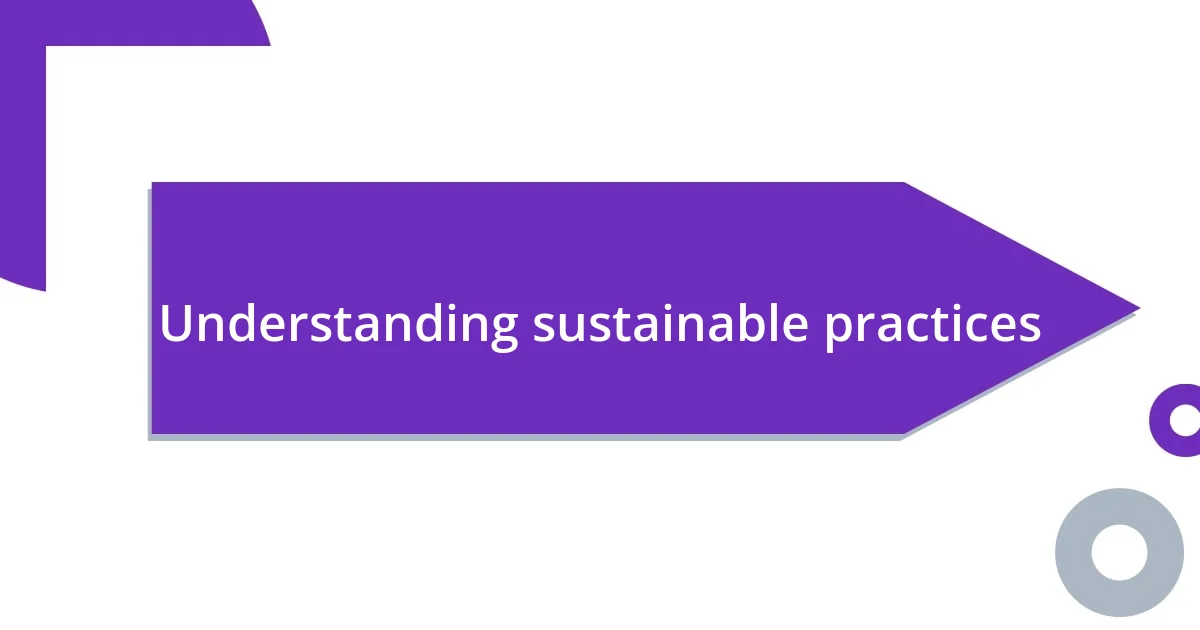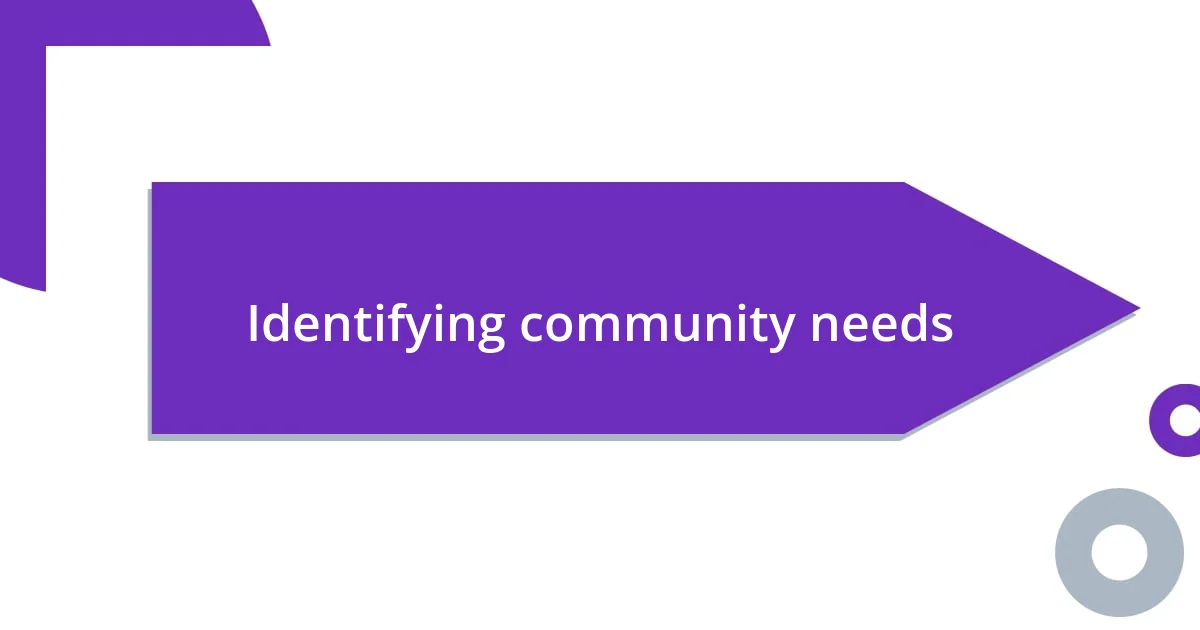Key takeaways:
- Sustainable practices involve community engagement and collaboration, leading to a significant positive impact on local initiatives, such as recycling and organic farming.
- Identifying community needs through observation and communication fosters deeper connections and enables a targeted approach to addressing local environmental issues.
- Measuring impact through feedback and visual storytelling promotes accountability and encourages ongoing participation in sustainability efforts.

Understanding sustainable practices
Sustainable practices are all about meeting our current needs without compromising the ability of future generations to meet theirs. To me, this means finding a balance; it’s like nurturing a garden where I ensure both my immediate needs and the health of the soil for years to come. Have you ever thought about the lasting impact of using resources wisely?
In my own community, I’ve seen the transformation that occurs when people genuinely embrace sustainability. For instance, our local recycling program started as a small initiative, but as community members began to recognize its importance, participation skyrocketed. It’s remarkable how a shared commitment to sustainability can create a ripple effect, wouldn’t you agree?
Sometimes, I think of sustainable practices as an ongoing conversation. One memorable moment for me was when the local farmers’ market encouraged conversations about organic farming. Hearing the passion from the farmers about protecting the environment really deepened my understanding of sustainable agriculture and its positive impact. When you connect sustainably with others, how can you not feel inspired?

Identifying community needs
Identifying community needs calls for a keen sense of observation and engagement. When I first started assessing what my community required, I took walks through different neighborhoods. I noticed things like neglected green spaces and an overwhelming amount of litter. These small details highlighted larger issues that needed attention. It struck me how often we overlook our surroundings until we take a moment to truly see them.
In my experience, organizing community meetings opened up a dialogue where residents felt heard. At one of these gatherings, I remember a woman passionately sharing her concerns about air quality. That moment resonated with me and showed just how critical it is to listen to voices often ignored. It became clear to me that identifying community needs is not just about data; it’s about human experiences and emotions that shape our environment.
To better understand these needs, I found it helpful to compare different aspects of community development. Gathering feedback through surveys and focus groups has allowed me to prioritize issues effectively—something I believe is essential for sustainable practice. When I reflect on this process, it reminds me that real change stems from understanding not only what we want but also what we truly need.
| Community Input Method | Insight Gained |
|---|---|
| Surveys | Quantitative data on community needs |
| Focus Groups | Qualitative insights and emotional connections |
| Community Meetings | Real-time feedback and immediate concerns |

Establishing local partnerships
Establishing local partnerships is one of the most effective strategies I’ve found in promoting sustainable practices. Over time, I’ve realized that collaboration amplifies individual efforts. For instance, I once teamed up with a local environmental group to organize a community cleanup day. The energy was infectious as residents came together, armed with gloves and trash bags, fueled by a shared goal. It was a true example of how pooling resources and passion can yield impressive results.
Here are some key aspects I focus on when forming these partnerships:
- Shared Goals: Align with organizations that have similar sustainability objectives to maximize impact.
- Community Engagement: Involve locals directly, fostering a sense of ownership and responsibility.
- Exchange of Resources: Leverage each partner’s strengths, whether it’s manpower, expertise, or materials.
- Long-term Commitment: Focus on building relationships that extend beyond a single project, ensuring sustained efforts in the community.
- Open Communication: Maintain transparent dialogue to cultivate trust and collaboration among all partners.
I’ve seen firsthand how these partnerships can create a network of support. The excitement on people’s faces when they collectively achieve something meaningful is something I’ll never forget. Each small success builds momentum, which inspires even more involvement in sustainable initiatives.

Organizing awareness campaigns
Organizing awareness campaigns can genuinely transform a community’s approach to sustainability. I remember planning a neighborhood event focused on reducing plastic waste. It was exciting to see how a simple idea could evolve into a day of learning and action. Participants crafted reusable bags from old t-shirts, which turned our workshop into a creative endeavor that was not only fun but also enlightening. How often do we take the time to explore innovative ideas together as a community?
I’ve found that storytelling is a powerful tool during these campaigns. When I shared my own experiences with pollution—like a day at the beach marred by litter—it struck a chord with many attendees. Suddenly, we weren’t just discussing facts and figures; we were connecting emotionally over shared memories and concerns for our environment. This connection made each participant feel like they played a role in the solution. After all, isn’t it easier to rally behind a cause when you understand its personal impact?
Planning these campaigns also involves continuous engagement beyond the initial event. One particular campaign I organized involved not only raising awareness but creating follow-up events, like clean-up drives and plant swaps. By fostering ongoing conversations, we kept the momentum going. Reflecting on this, I often wonder: how can we maintain that spark of enthusiasm once the initial excitement of an event fades away? Ultimately, it’s about creating a culture of sustainability that endures, one conversation at a time.

Implementing eco-friendly initiatives
Implementing eco-friendly initiatives often starts with small, tangible actions that create significant ripple effects. For example, I coordinated a tree-planting event in my local park, where families not only learned about the importance of trees but also dug their hands in the dirt alongside their children. Watching kids get excited about planting their own tree and nurturing it over the years has been one of the most rewarding experiences in my journey toward sustainability. Isn’t it fascinating how nurturing a tiny sapling can nurture a sense of responsibility towards our planet?
In my experience, involving local businesses can amplify these initiatives remarkably. I approached a café owner who was passionate about sustainability, and together, we introduced a discount for customers who brought their own cups. Immediately, I noticed more people carrying their reusable mugs, turning a simple incentive into a movement. The café buzzed with conversations about eco-friendliness, and I could feel that shared commitment evolving—who would have thought a little discount could spark such enthusiasm for change?
Moreover, I believe that offering workshops can provide hands-on experience that fosters a deeper understanding of eco-friendly practices. I once hosted a workshop on composting at a community center. As participants sifted through materials and built their compost bins, I saw the excitement in their eyes. It wasn’t just about learning; it was about empowering each other to make sustainable choices in our daily lives. Have you ever thought about how a little dirt can connect us with nature and our community? I left feeling invigorated, knowing that each person walked away equipped with new knowledge to change their habits for the better.

Encouraging community involvement
Engaging my community in sustainable practices often begins with creating opportunities for dialogue. I vividly recall a town hall meeting where we discussed local environmental challenges. As I listened to residents voice their concerns about pollution and waste management, I felt a wave of collective urgency. It was evident that when people share their struggles, they’re more willing to explore solutions together. Isn’t it amazing how discussions can transform individual concerns into a united mission for change?
I’ve found that organizing regular community clean-ups not only beautifies our surroundings but also fosters a strong sense of kinship. At our last clean-up, an elderly gentleman shared stories from his childhood, reminiscing about how the same park once flourished with wildlife. His stories resonated deeply, sparking a shared commitment to restore that beauty. These moments spur conversations, turning mere participation into a personal stake in our environment. Have you ever experienced the power of connecting with others while working toward a common goal?
Additionally, I love celebrating our achievements together. After completing a series of workshops on sustainable living, we held a community potluck to showcase our culinary creations using locally sourced ingredients. The energy was infectious, and it brought a delightful touch of warmth to our efforts. Everyone left with their bellies full and hearts lighter, and it reinforced that sustainability isn’t just a job—it’s a lifestyle we can truly enjoy together. How often do you think that joy plays a role in fostering long-term community engagement?

Measuring impact and progress
Measuring the impact of our sustainable practices is essential for understanding what works and what needs adjustment. I remember after a year of implementing our community garden, we conducted a survey to gauge its influence on local food awareness. The results were eye-opening; over 70% of participants reported increased knowledge about organic gardening. It made me realize how vital feedback is in shaping our ongoing efforts. Have you ever considered how simply asking for community input can elevate a project?
Tracking progress doesn’t have to be complicated either. For instance, I started a simple monthly community bulletin that highlighted our initiatives and shared success stories. One month, I showcased families who had drastically reduced their waste by composting, leading to others taking similar steps in their households. The tangible evidence of progress sparked a conversation about expanding our composting program, showcasing how small victories can create a broader dialogue. Isn’t it rewarding to witness how shared stories can inspire action in others?
Lastly, I firmly believe that using visual storytelling enhances our understanding of progress. Whenever we host events, I capture photos and create collages that reflect our journey toward sustainability. I fondly recall the pride I felt when displaying a before-and-after of a greenhouse renovation project we undertook. Seeing the transformation not only re-energized the team but also served as a visual reminder of our commitment. How powerful is it to visualize our efforts and motivate ourselves and others toward continual improvement?














